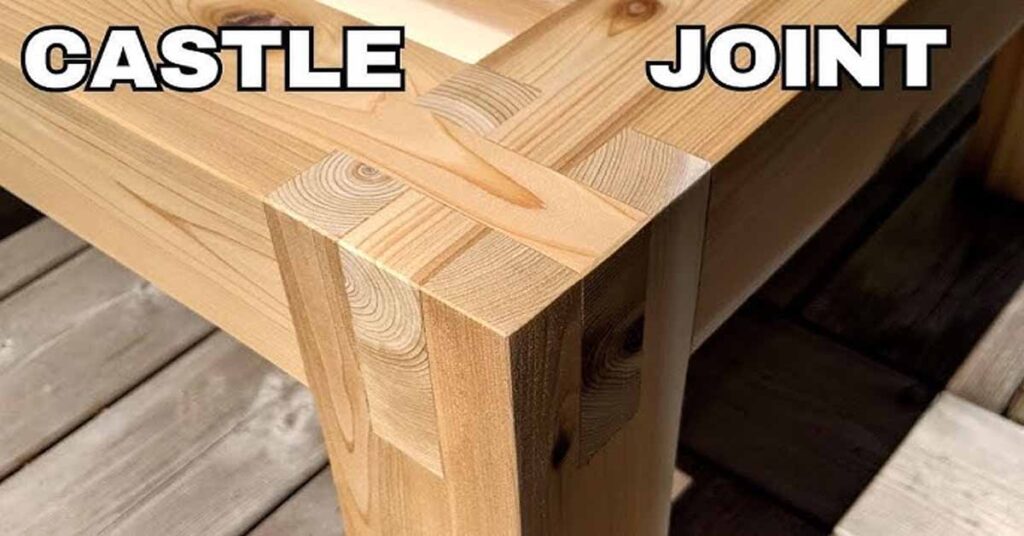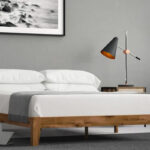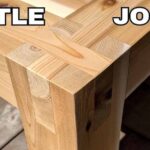Discover exquisite craftsmanship and durability with Japanese Joinery Bed Frames. These beds are meticulously crafted with precision joinery techniques, ensuring a sturdy and long-lasting frame.
The intricate joinery not only enhances the structural integrity but also adds a touch of elegance to the design. From platform beds to headboard options, these frames offer a seamless blend of traditional Japanese craftsmanship and modern aesthetics, making them a popular choice for those seeking both style and functionality in their bedroom furniture.
With a wide range of sizes and finishes available, Japanese Joinery Bed Frames can effortlessly complement various interior design themes while providing unparalleled support and comfort for a restful night’s sleep.
The History Of Japanese Joinery bed
Japanese joinery has a rich history dating back centuries. The meticulous craftsmanship and precision of Japanese woodworking techniques have made Japanese joinery bed frames a symbol of elegance and durability.
Traditional Japanese Woodworking Techniques
Traditional Japanese woodworking techniques emphasize precision and durability, using intricate joinery methods to create sturdy and beautiful furniture pieces like the Japanese style bed frame.
Significance Of Joinery In Japanese Culture
Joinery holds significant cultural value in Japan, reflecting the country’s craftsmanship tradition and attention to detail. The Japanese joinery bed frame with headboard exemplifies the fusion of aesthetics and functionality in Japanese design.

Introduction To Japanese Joinery Bed Frame
Japanese joinery bed frame, often referred to as a Japanese style bed or Japanese style bed frame, is a timeless and elegant piece of furniture known for its exceptional craftsmanship and durability. These beds are constructed using traditional Japanese joinery techniques that rely on interlocking wooden joints for stability, eliminating the need for metal hardware.
Unique Features Of A Japanese Joinery Bed
- Interlocking wooden joints for stability
- Minimalist design with clean lines
- Natural wood finishes
- Durable construction for long-lasting use
- Customizable headboard options
Benefits Of Using A Japanese Joinery Bed Frame
- Enhanced durability and stability
- Timeless aesthetic appeal
- Supports good posture and spine alignment
- Environmentally friendly construction
- Easy to assemble and disassemble for moving
Types Of Japanese Joinery Bed Frames
Japanese joinery bed frames are known for their exquisite craftsmanship and durability. With various types, including platform and low headboard designs, these beds feature intricate wood joinery without the need for metal hardware. Each frame is a stunning blend of function and artistry, perfect for those seeking a unique and timeless sleeping experience.
Tatami Bed Frames
The Tatami bed frames, inspired by traditional Japanese style, offer a minimalist and low-profile design. These Japanese joinery beds frames are usually made of sustainable materials and provide a comfortable sleeping platform.
Futon Bed Frames
Futon bed frames are known for their versatility and space-saving features. They can be easily folded and stored, making them ideal for smaller living spaces. A Japanese-style bed frame with futon is a popular choice for those seeking both comfort and convenience.
Platform Bed Frames
Platform bed frames, characterized by their solid platform base, are a timeless choice for a Japanese joinery bed frame with headboard. They are available in various styles, from modern to traditional, and offer excellent support for mattresses without the need for a box spring.
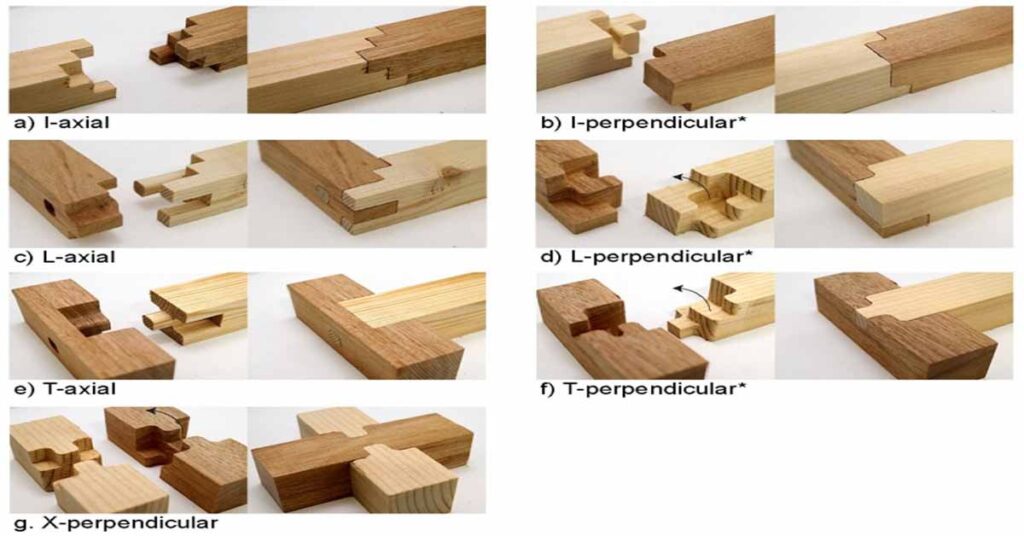
Materials Used In Japanese Joinery Bed Frames
Japanese joinery bed frames are crafted with high-quality materials that ensure durability and stability. These frames often feature solid wood, such as oak or cedar, and are constructed using traditional woodworking techniques that result in a beautiful and long-lasting piece of furniture.
Japanese joinery a bed frames are known for their durability, craftsmanship, and timeless beauty. These bed frames are meticulously crafted using high-quality materials that ensure longevity and comfort. In this article, we will explore the materials commonly used in Japanese joinery bed frames, including wood selection criteria and the difference between traditional and modern materials.
Wood Selection Criteria
When it comes to Japanese joinery bed frames, wood selection plays a crucial role in determining the overall quality and aesthetic appeal of the bed frame. Japanese craftsmen carefully choose woods that meet specific criteria. These criteria include:
| Criterion | Description |
| Strength | The wood should be strong enough to support weight and withstand daily use. |
| Stability | The wood should be resistant to warping and shrinkage, ensuring the bed frame remains sturdy and durable. |
| Beauty | The wood should have a natural beauty, with unique grains and textures that enhance the overall aesthetic of the bed frame. |
| Sustainability | Many Japanese joinery bed frames use sustainably sourced wood, ensuring the bed frame is eco-friendly and supports responsible forestry practices. |
Traditional Vs. Modern Materials
Traditional Japanese joinery bed frames were mainly crafted using native Japanese woods such as hinoki (Japanese cypress), keyaki (zelkova), and kiri (paulownia). These woods have been used for centuries due to their durability, natural beauty, and inherent properties that make them suitable for crafting intricate joinery.
However, in modern times, due to the scarcity and high cost of traditional Japanese woods, craftsmen also incorporate other high-quality woods such as oak, cherry, and walnut into their creations. These woods offer similar properties to the traditional materials, ensuring the quality and longevity of the bed frame. In addition to wood, modern Japanese joinery beds frames may also incorporate other materials such as metal or fabric in their designs. These materials are often used for headboards or as accents, providing a contemporary touch to the overall aesthetic of the bed frame.
In conclusion, Japanese joinery bed frames are crafted using carefully selected woods that meet specific criteria such as strength, stability, beauty, and sustainability. While traditional Japanese woods hold a special place in the craftsmanship of these bed frames, modern materials such as oak, cherry, and walnut also contribute to their durability and aesthetic appeal. The use of different materials allows craftsmen to create unique and personalized designs that cater to individual preferences and interior styles. Explore the wide range of Japanese-joinery bed frames available to add a touch of elegance and craftsmanship to your bedroom.
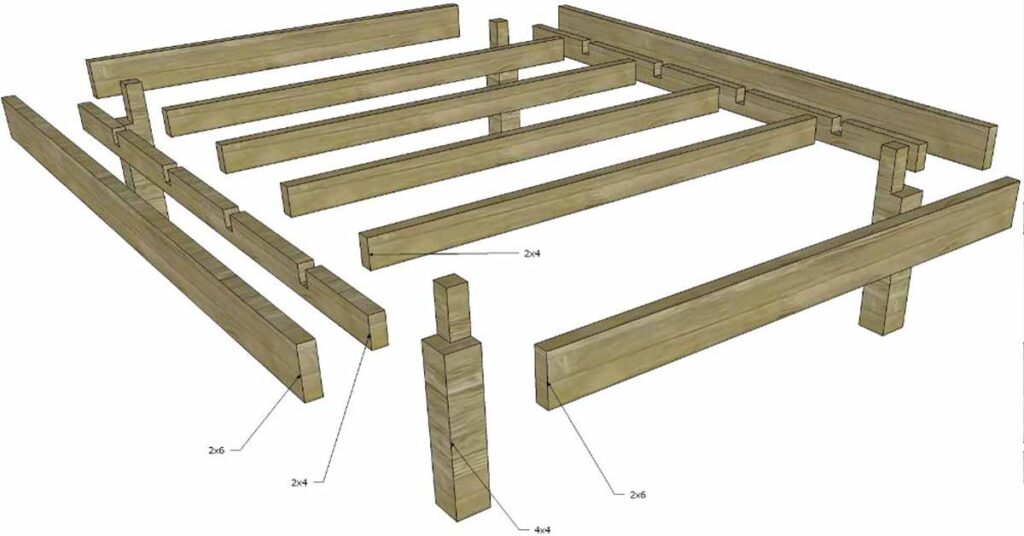
Design Elements Of Japanese Joinery Bed Frames
Japanese joinery bed frames are renowned for their exquisite craftsmanship and unique design elements that set them apart in the realm of furniture. From their minimalistic aesthetics to the incorporation of nature-inspired designs, Japanese-style bed frames offer a harmonious blend of functionality and beauty.
Minimalistic Aesthetics
- The Japanese style bed frame embraces simplicity, with clean lines and a minimalist approach that creates a serene and clutter-free sleeping space.
- Each element in a Japanese joinery bed frame with headboard is thoughtfully designed to serve a purpose while maintaining an elegant and uncluttered look.
Incorporating Nature-inspired Designs
- Nature plays a significant role in the design of japanese-style bed frames, with elements such as wood textures, earthy tones, and organic shapes that bring a sense of tranquility to the bedroom.
- The use of natural materials like wood and bamboo in Japanese joinery bed frames reflects a deep connection to nature and enhances the overall aesthetic appeal of the piece.
Embracing the essence of minimalism and nature, Japanese-joinery bed frames stand as a testament to the timeless beauty and craftsmanship of Japanese design.
Construction Techniques Of Japanese Joinery Bed Frames
Japanese joinery bed frames are known for their exquisite craftsmanship and durability. The construction techniques used in creating these beds showcase the artistry and precision of Japanese carpentry.
Dovetail Joints
- Dovetail joints are a classic Japanese joinery method that creates strong and visually appealing connections.
- The interlocking design of dovetail joints ensures stability and longevity for the Japanese style bed frame.
- Craftsmen meticulously cut and fit these joints together to form a seamless and sturdy structure.
Mortise And Tenon Joints
- Mortise and tenon joints are another traditional Japanese woodworking technique used in bed frame construction.
- This method involves the insertion of a tenon (a protruding piece) into a mortise (a cavity or slot) to create a secure connection.
- Japanese joinery bed frames with mortise and tenon joints exhibit precision and strength in their construction.
Half-lap Joints
- Half-lap joints are a versatile joinery technique commonly used in Japanese style bed frames.
- This method involves cutting half the thickness of each intersecting piece to create a flush connection.
- The clean and minimalist look of half-lap joints adds to the aesthetic appeal of Japanese joinery bed frames with headboard.
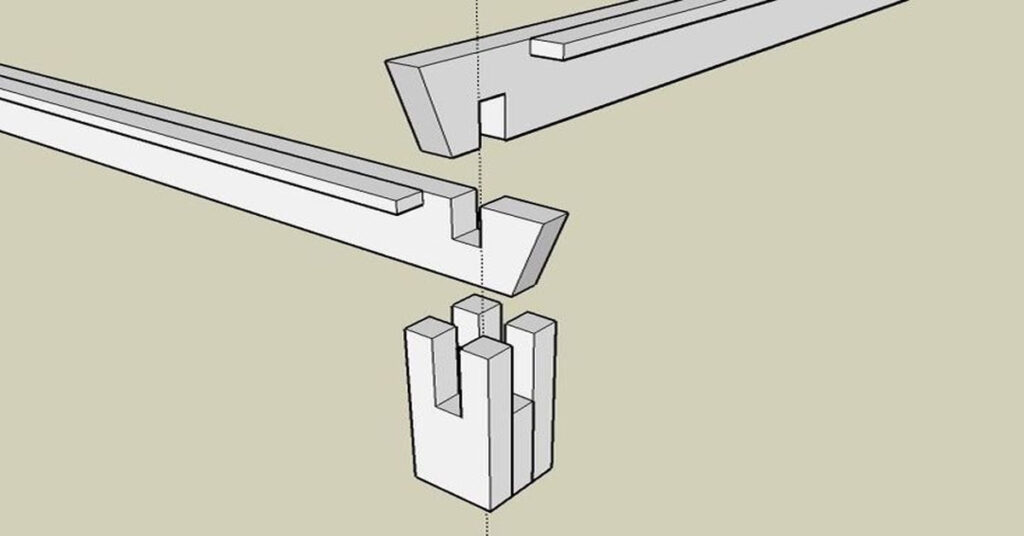
Benefits Of Owning A Japanese Joinery Bed Frame
Discover the numerous benefits of owning a Japanese joinery beds frame, including its durability, minimalist design, and superior craftsmanship. Experience the perfect combination of aesthetics and functionality with this beautifully crafted bed frame.
Durability And Longevity
A Japanese joinery bed frame boasts exceptional durability and longevity due to its meticulously crafted wooden joints that rely on precise woodworking techniques.
Environmental Sustainability
The use of high-quality wood sourced from sustainable forests in crafting a Japanese joinery bed frame ensures minimal environmental impact, promoting sustainability.
Enhanced Sleep Quality
Experience improved sleep quality with a Japanese joinery bed frame that provides excellent support and stability, contributing to a restful night’s sleep.
Choosing The Right Japanese-Joinery Bed Frame
When selecting a Japanese joinery bed frame, consider various factors to ensure that it complements your space seamlessly. From the room size and layout to matching design aesthetics with decor, every detail plays a crucial role in elevating your bedroom’s ambiance.
Considering Room Size And Layout
- Measure your room to determine the ideal bed frame size.
- Opt for a low-profile Japanese style bed if you have limited space.
- Ensure there is ample space around the bed for easy movement.
Matching Design Aesthetics With Decor
- Choose a Japanese joinery bed frame that complements your existing decor.
- Consider the material and color of the bed frame to align with the room’s theme.
- Ensure the headboard design of the Japanese joinery bed frame harmonizes with your style.
By keeping these points in mind, you can effortlessly select the perfect Japanese joinery bed frame that not only enhances the visual appeal of your bedroom but also provides comfort and functionality.
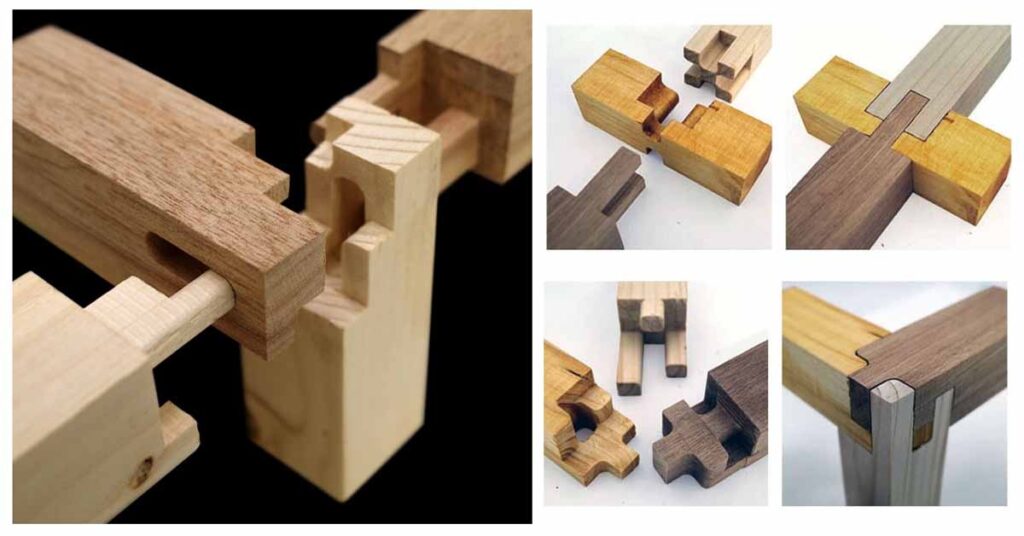
Maintaining A Japanese Joinery Bed Frame
Investing in a Japanese joinery bed frame can bring both elegance and durability to your bedroom. However, to ensure its longevity, proper care and maintenance are essential. Here are some tips for maintaining your Japanese style bed frame in pristine condition.
Cleaning And Care Tips
Regular cleaning is crucial to preserve the beauty and functionality of your japanese joinery bed frame with headboard. Here are some cleaning and care tips to keep in mind:
- Use a soft, damp cloth to wipe down the bed frame regularly to remove dust and dirt.
- For stubborn stains, use a mild cleaning solution and avoid harsh chemicals that may damage the wood.
- Ensure proper ventilation in the room to prevent moisture buildup, which can potentially damage the frame.
- Periodically inspect the frame for any loose joints or signs of wear and tear.
Repairing Common Issues
Despite proper care, Japanese style bed frames may encounter common issues that require repairs. Here’s how to address some of these issues:
- Loose Joints: Apply wood glue to reattach loose joints and secure them in place. Use clamps to hold the joints together while the glue dries.
- Surface Scratches: Lightly sand the scratched area and apply a matching wood finish to restore the surface.
- Water Damage: If the frame experiences water damage, use a fan to dry the affected area thoroughly and consider refinishing as needed.
Cost Considerations Of Japanese Joinery Bed Frames
The cost considerations of Japanese joinery bed frames vary, with prices ranging from $300 to $1500 depending on the size, design, and materials used. Factors like the type of wood, craftsmanship, and additional features contribute to the overall price but offer long-lasting and unique bed frames.
Explore various retailers for competitive prices and options.
Factors Affecting Price
When considering a Japanese joinery bed frame, it’s important to understand the various factors that can affect its price. These factors include the materials used, the craftsmanship involved, and the overall design and complexity of the bed frame.
1. Materials: The choice of materials can greatly impact the price of a Japanese joinery bed frame. High-quality woods such as oak, mahogany, or walnut will typically cost more than softer woods like pine or birch. Additionally, the finish and treatment of the wood can also contribute to the overall cost.
2. Craftsmanship: Japanese joinery is known for its meticulous and precise craftsmanship. The more intricate and complex the joinery techniques used in the bed frame, the more skilled labor and time it requires, resulting in a higher price.
3. Design and Complexity: Japanese joinery bed frames come in a variety of styles and designs, ranging from simple and minimalistic to ornate and detailed. The level of intricacy and complexity in the design will impact the price accordingly.
Budget-friendly Alternatives
If you’re working with a limited budget but still want to enjoy the beauty and craftsmanship of a Japanese style bed frame, there are a few alternatives to consider.
1. DIY: Consider building your own Japanese joinery bed frame using readily available plans or tutorials. This allows you to customize the design and use more affordable materials while still incorporating traditional joinery techniques.
2. Second-hand: Look for second-hand or vintage Japanese joinery bed frames. These can often be found at a lower price compared to brand new ones, and you may even find unique and rare designs.
3. Hybrid designs: Some furniture makers offer hybrid designs that combine traditional Japanese joinery techniques with more affordable materials or mass-produced components. These bed frames can offer a similar aesthetic while reducing costs.
4. Simpler designs: Opting for a simpler design with fewer intricate details and joinery techniques can also help lower the price of a Japanese joinery bed frame. Focus on the essential elements of the design while maintaining the elegance and functionality.
Remember, when investing in a Japanese joinery bed frame, it’s not just about the price but the quality and craftsmanship that will ensure its durability and longevity. Take the time to evaluate your options, consider your budget, and choose a bed frame that suits your needs and personal style.
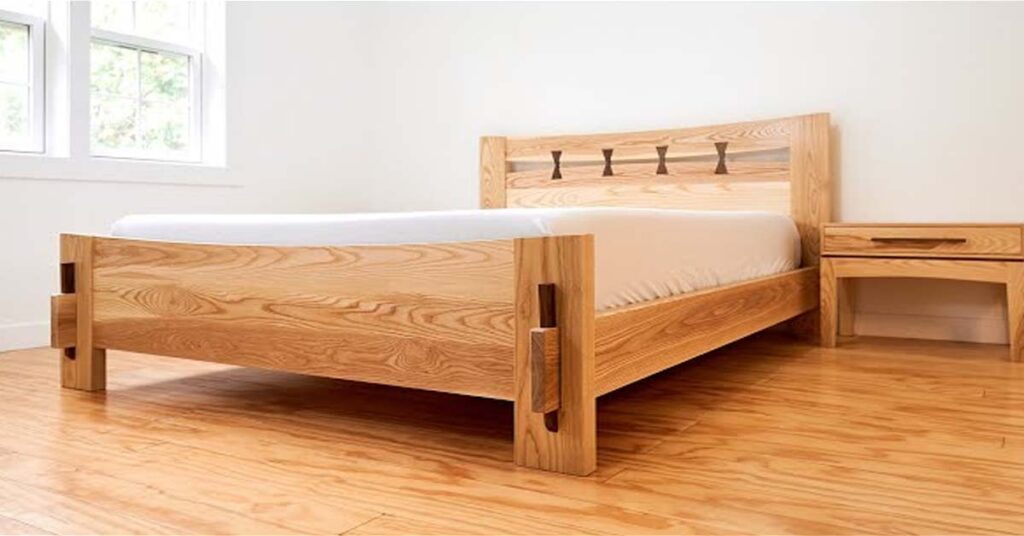
Incorporating Japanese Joinery Into Modern Interior Design
Experience the timeless elegance of Japanese joinery by incorporating a minimalist Japanese joinery bed frame into modern interior design. Combining functionality with aesthetic appeal, the bed frame showcases craftsmanship and precision in a stylish and serene setting. This seamless fusion creates a tranquil ambiance, perfect for relaxation.
Mixing Traditional And Contemporary Styles
When it comes to interior design, mixing traditional and contemporary styles can create a visually stunning and unique aesthetic. Incorporating Japanese joinery into modern interior design is a prime example of this fusion. The Japanese joinery bed frame seamlessly blends the elegance of traditional Japanese craftsmanship with the sleek lines and minimalist design of contemporary style. With its clean lines and minimalist aesthetic, the Japanese joinery bed frame effortlessly complements modern interior design.
The use of sturdy wooden beams and intricate joinery techniques adds a touch of traditional craftsmanship to the overall design. The result is a bed frame that not only provides a functional and comfortable sleeping space but also serves as a statement piece in any modern bedroom.
Creating A Zen-inspired Bedroom
One of the key elements of Japanese joinery bed frames is their ability to create a Zen-inspired bedroom. The simplicity and natural beauty of these bed frames evoke a sense of tranquility and calmness that is synonymous with Japanese design principles. Incorporating a Japanese joinery bed frame with headboard into your bedroom can instantly transform it into a serene and inviting space.
The minimalist design, combined with the use of natural materials, such as wood, creates a connection with nature and promotes a sense of harmony. To enhance the Zen-inspired atmosphere, consider pairing the Japanese joinery bed frame with simple and clean bedding, such as neutral-colored sheets and comforters. Avoid clutter and keep the room well-organized to maintain a sense of calmness. Additionally, incorporating natural elements, such as indoor plants or a small water feature, can further enhance the tranquil ambiance of the space.
By incorporating Japanese joinery into modern interior design, you can create a cohesive and visually captivating space that combines the best of traditional and contemporary styles. The Japanese joinery bed frame with headboard serves as a centerpiece in the bedroom, instantly elevating the overall aesthetic. Embracing the Zen-inspired principles of simplicity, minimalism, and connection with nature, this bed frame offers both functional comfort and a visually pleasing design.
Famous Japanese Joinery Bed Frame Manufacturers
Experience the remarkable craftsmanship of Hida Tool & Craft, a renowned manufacturer of Japanese joinery bed frames. Their attention to detail and traditional woodworking techniques result in exceptionally sturdy and visually appealing bed frames.
Discover the elegance of Karup Design’s Japanese style bed frames. With a focus on minimalist aesthetics and functionality, Karup Design offers a range of exquisitely designed Japanese joinery bed frames that seamlessly blend into any modern bedroom setting.
Table of Contents
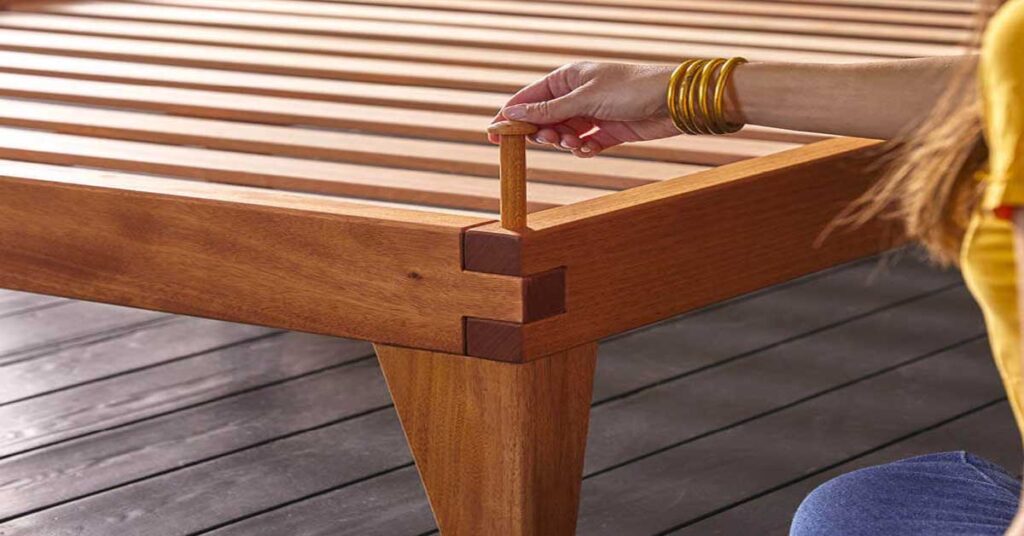
Cultural Influence Of Japanese-Joinery Bed Frames
Japanese joinery bed frames are not just a pieces of furniture; they represent a deep cultural influence and a harmonious blend of tradition and craftsmanship. The uniqueness and elegance of a Japanese style bed frame go beyond mere functionality, reflecting the rich heritage of Japanese joinery and design principles.
Connection To Japanese Tea Ceremony
The Japanese joinery bed frame is deeply rooted in the Japanese tea ceremony culture, where every minor detail holds significance. This art of preparing and serving tea epitomizes simplicity, tranquility, and respect. Similarly, the construction of a Japanese joinery bed frame with headboard exemplifies precision and attention to detail, mirroring the meticulousness of the tea ceremony. The clean lines and minimalistic design of the bed frame evoke a sense of serenity, aligning with the core values of the Japanese tea ceremony.
Symbolism Of Balance And Harmony
The Japanese style bed frame symbolizes the profound Japanese philosophy of finding harmony in all things. Constructed with intricate joinery techniques, these bed frames achieve a perfect balance between form and function. The use of natural materials and the seamless integration of elements represent the principle of wabi-sabi, embracing imperfection and transience. This symbolism embodies a holistic approach to life and resonates with the idea of achieving equilibrium and tranquility within one’s living space.
Diy Japanese Joinery Bed Frame Projects
Discover the art of crafting your own Japanese-Joinery Bed Frame projects for a touch of elegance. Learn the intricate techniques that make these designs unique and stylish. Elevate your bedroom with a DIY Japanese Joinery Bed Frame masterpiece.
If you’re looking to add a touch of elegance and simplicity to your bedroom, why not consider building your own Japanese joinery beds frame? The Japanese style bed frames have become increasingly popular due to their minimalist design and sturdy construction. Not only will you have a unique and stylish bed, but you’ll also have the satisfaction of building it yourself.
Step-by-step Guides
Building a Japanese joinery bed frame might seem daunting at first, but with the right step-by-step guide, it can be a rewarding project. Here’s a breakdown of the process:
- Start by measuring and cutting the wood to the desired dimensions for your bed frame.
- Next, assemble the frame using the traditional Japanese joinery techniques like mortise and tenon or dovetail joints.
- Once the frame is complete, add the slats or platform for the mattress support.
- Finally, sand and finish the bed frame to ensure a smooth and polished look.
Tools Required For The Project
To successfully build your own Japanese joinery beds frame, you’ll need a few essential tools. Here’s a list of the tools you’ll need:
| Saw | Chisel | Wood plane |
| Measuring tape | Clamps | Sanding block |
| Drill | Hammer | Finishing nails |
With these tools in your arsenal, you’ll be well-equipped to tackle your DIY Japanese joinery bed frame project. Remember to take your time and follow the step-by-step guide to ensure a successful outcome. Soon enough, you’ll have a beautiful Japanese-joinery bed frame to enhance the aesthetics of your bedroom.
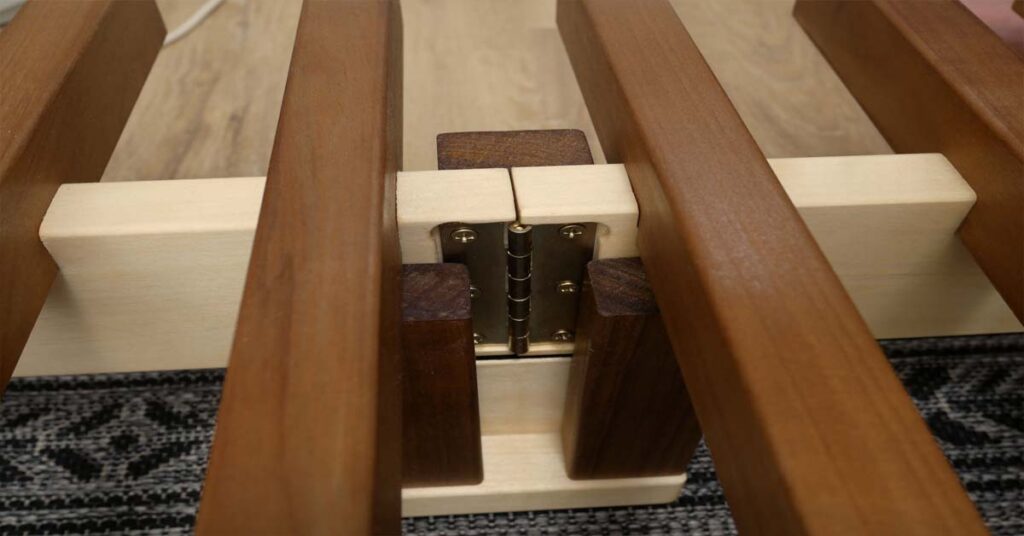
Comparison Of Japanese Joinery Frames of BedWith Western Designs
Japanese joinery bed frames offer a minimalist and elegant design, showcasing exquisite craftsmanship and durability. In contrast to Western designs, Japanese joinery focuses on utilizing precision-cut wood joinery techniques, elevating the overall aesthetic and creating a stable structure for a peaceful slumber.
Perfect for those seeking a blend of functionality and artistry in their bedroom decor.
Aesthetics And Functionality Differences
Japanese joinery bed frames and Western designs differ significantly in both aesthetics and functionality. In terms of aesthetics, Japanese joinery bed frames are known for their minimalistic and Zen-inspired designs. They typically feature clean lines, low profiles, and natural materials like wood. Japanese style beds emphasize simplicity and create a sense of tranquility in the bedroom environment.
On the other hand, Western bed frames often showcase more ornate and extravagant designs. They may incorporate intricate details, decorative elements, and different types of materials like metal or upholstery. Western designs can range from traditional to modern, depending on the individual’s preferences. When it comes to functionality, Japanese joinery bed frames prioritize efficiency and space-saving. These beds are designed to maximize the use of the available space, making them ideal for smaller bedrooms or apartments. They often feature built-in storage compartments or drawers underneath the mattress for convenient organization.
In contrast, Western bed frames tend to focus more on comfort and customization. They can come in various sizes and configurations to cater to different sleeping preferences. Western designs may include features like adjustable headboards or footboards, allowing users to find their desired sleeping position easily.
Cultural Perceptions Of Furniture
Cultural perceptions of furniture also play a significant role in the differences between Japanese joinery bed frames and Western designs. In Japanese culture, furniture holds a special place in people’s lives. Japanese style beds are considered essential for creating a harmonious and peaceful environment for rest and relaxation. The emphasis on simplicity and natural materials reflects the traditional values of minimalism and closeness to nature in Japanese culture.
In contrast, Western culture often sees furniture as more than just functional objects. Western bed frames are often seen as a means of self-expression and personal style. They can be used to showcase one’s individuality and personality, with the design and materials reflecting personal tastes and preferences.
Overall, the comparison of Japanese joinery bed frames with Western designs reveals the distinct differences in aesthetics, functionality, and cultural perceptions. While Japanese style beds prioritize minimalism and efficiency, Western bed frames offer more customization and reflect individualistic values. Ultimately, the choice between the two depends on personal preferences and the desired atmosphere in the bedroom.
Environmental Impact Of Japanese Joinery Bed Frame Production
The environmental impact of Japanese joinery bed frame production is a significant aspect to consider when investing in a sustainable and eco-friendly sleeping solution. By understanding the sustainability practices in woodworking and the use of eco-friendly finishes, customers can make informed decisions that align with their environmental values.
Sustainability Practices In Woodworking
Japanese joinery bed frames utilize traditional woodworking techniques that are known for their exceptional durability and longevity. The construction process involves meticulous joinery methods such as mortise and tenon, dovetail, and halving joints, which eliminate the need for metal fasteners or adhesives. This approach not only promotes the longevity of the bed frame but also reduces the reliance on non-renewable resources.
Use Of Eco-friendly Finishes
In addition to the sustainable construction techniques, Japanese style bed frames often incorporate eco-friendly finishes such as natural oils and waxes. These finishes are derived from renewable sources and contain minimal or no volatile organic compounds (VOCs), promoting better indoor air quality and reducing the overall environmental impact of the production process.
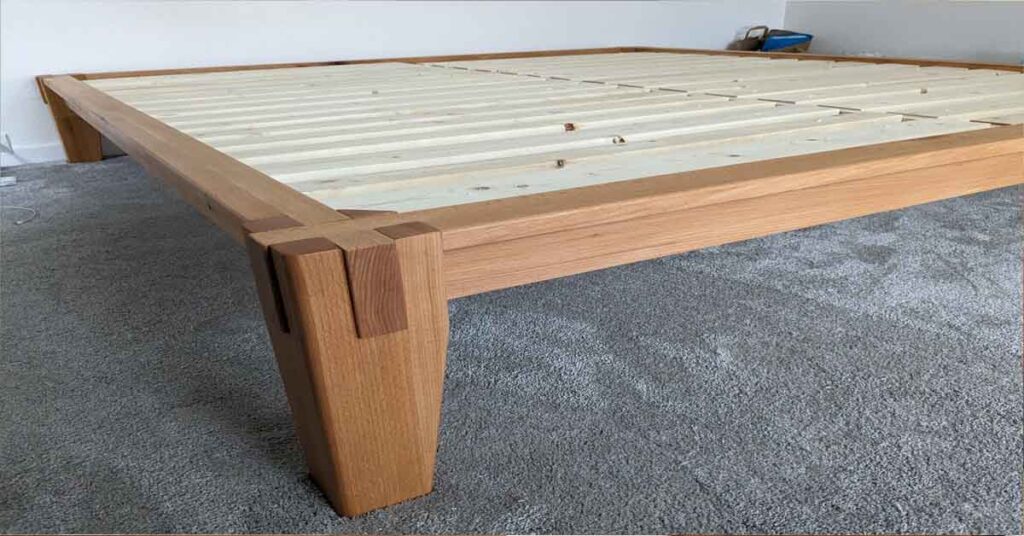
Future Trends In Japanese Joinery Bed Frame Design
In the ever-evolving world of furniture design, the Japanese joinery bed frame continues to captivate with its timeless elegance and functional appeal. As we look ahead to the future, several trends are shaping the landscape of Japanese style bed frames. Let’s explore the exciting developments that are pushing the boundaries of traditional craftsmanship.
Integration Of Smart Features
With technology becoming an integral part of our daily lives, the integration of smart features into Japanese-joinery bed frames is gaining traction. From built-in USB ports and wireless charging capabilities to adjustable settings for optimal comfort, these innovative additions are transforming the way we interact with our furniture.
Innovations In Sustainable Materials
As sustainability takes center stage in design ethos, there is a growing emphasis on incorporating eco-friendly materials into Japanese style bed frames. From reclaimed wood and bamboo to recycled steel and organic fabrics, designers are pushing the boundaries of what’s possible while staying committed to responsible sourcing and production practices.
By embracing these future trends in Japanese joinery bed frame design, we are witnessing a harmonious blend of tradition and innovation that promises to redefine the way we experience comfort and style in our living spaces.
References For Further Exploration
When it comes to building a Japanese joinery bed frame, it’s essential to have reliable references for further exploration. Whether you’re a woodworker looking to incorporate Japanese style bed frame into your craft or simply passionate about this elegant and timeless design, the following resources will deepen your understanding and enhance your skills.
Books On Japanese Woodworking
- 1. “The Complete Manual of Woodworking” by Albert Jackson and David Day: This comprehensive guide covers various woodworking styles, including Japanese joinery. It is an invaluable resource for understanding the principles and techniques behind constructing a Japanese style bed frame.
- 2. “The Art of Japanese Joinery” by Kiyosi Seike: A renowned master carpenter, Seike provides detailed explanations and visual demonstrations of traditional Japanese woodworking. This book is a treasure trove for anyone wanting to delve deeper into the intricacies of Japanese joinery bed frames.
Online Resources And Workshops
- 1. FineWoodworking.com: This website offers a plethora of articles, videos, and forums dedicated to Japanese joinery and woodworking techniques. You can engage with a community of woodworkers and gain insights from experts in the field.
- 2. The Joinery Workshop at Kyoto University of Art and Design: Consider enrolling in workshops or online courses offered by esteemed institutions like Kyoto University of Art and Design. These programs provide hands-on experience and in-depth knowledge of Japanese joinery, enabling you to apply the principles to your Japanese joinery bed frame with headboard project.
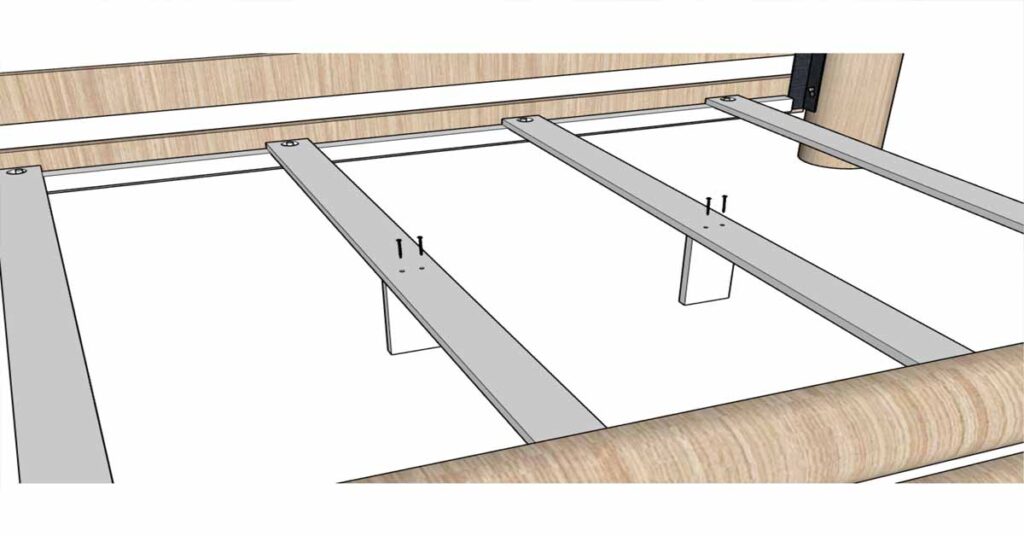
people want to know About Japanese Joinery Bed Frames
Are Japanese Joinery Bed Frames Expensive?
If you’re wondering about the cost of a Japanese joinery beds frame, you’ll be pleased to know that they are available at various price points to suit different budgets. The price of a Japanese-joinery bed frame can depend on factors such as the type of wood used, the design intricacy, and the size of the bed frame. While some Japanese joinery bed frames may be considered high-end luxury furniture, there are also more affordable options available.
For example, you can find Japanese-joinery bed frames on popular online retailers like Amazon.com, Wayfair, and Bed Bath & Beyond, with prices ranging from around $300 to over $1000. Additionally, local furniture stores may offer Japanese joinery bed frames within a similar price range. It’s worth noting that the craftsmanship and quality associated with Japanese joinery bed frames often justify the price, as they are built to last and offer timeless elegance.
Can Japanese Joinery Beds Support Regular Mattresses?
If you already have a regular mattress and are interested in a Japanese joinery beds frame, you may be wondering if the two are compatible. The good news is that most Japanese joinery bed frames can accommodate regular mattresses, eliminating the need for special bedding. Whether you have a twin, queen, or king-size mattress, there are Japanese-joinery bed frames available to suit your needs.
Japanese-joinery bed frames typically feature slats or a platform design that provides excellent support for different types of mattresses. These bed frames are designed to promote comfort, stability, and airflow, ensuring a restful night’s sleep. However, it’s always a good idea to check the specifications of the specific Japanese joinery beds frame you are interested in to ensure it can support your preferred mattress size.
With their unique design and impeccable craftsmanship, Japanese joinery bed frames offer a stylish and functional addition to any bedroom. Whether you’re in search of a statement piece or simply want to experience the beauty of Japanese aesthetics, a Japanese joinery beds frame with a headboard is sure to delight. Explore your options and discover the perfect Japanese joinery beds frame to complement your sleep space.
Frequently Asked Questions
Are you considering purchasing a Japanese joinery bed frame, also known as a Japanese style bed frame? If so, you probably have some questions about these unique and beautiful pieces of furniture. In this section, we will answer some frequently asked questions about Japanese joinery bed frames to help you make an informed decision.
Are Japanese Bed Frames Good?
Yes, Japanese bed frames are good. They are well-known for their durability and craftsmanship. Japanese joinery techniques ensure solid and sturdy construction, making them a reliable choice. Additionally, they have a minimalist design that can fit well in various interior styles.
What Are Japanese Platform Beds Called?
Japanese platform beds are called “tatami beds” in reference to the traditional straw mats used.
What Is Japanese Wood Joinery Called?
Japanese wood joinery is called “Sashimono. ” It involves intricate, precise interlocking wooden joints for structures or furniture.
What Is A Tatami Bed Frame?
A tatami bed frame is a traditional Japanese-style platform bed frame made of wooden slats or rice straw mats.
What Is Japanese Joinery And How Is It Used In Bed Frames?
Japanese joinery is a traditional woodworking technique that uses precise, interlocking joints to construct furniture. In bed frames, it ensures stability and durability.
Why Choose A Japanese Joinery Bed Frame Over Other Options?
A Japanese joinery bed frame offers superior strength and longevity compared to other bed frame options. Its interlocking joints provide excellent stability, ensuring a peaceful and comfortable sleep.
Conclusion: Embracing Japanese Joinery Bed Frames
Embrace the beauty and craftsmanship of Japanese joinery bed frames, expertly designed to provide both style and durability. Experience the elegance of these unique bed frames, adding a touch of Eastern influence to your bedroom decor.
Appreciating Traditional Craftsmanship
Traditional craftsmanship shines through in every detail of a Japanese joinery bed frame, showcasing exquisite woodworking skills.
The intricate joints and connections are a testament to the mastery of Japanese artisans who have perfected the art over centuries.
Enhancing Living Spaces With Timeless Elegance
Experience the timeless elegance of a Japanese style bed frame that seamlessly blends with modern and traditional decor alike.
The minimalist design and clean lines of a Japanese joinery bed frame with headboard add a touch of sophistication to any bedroom.
Conclusion
Incorporating Japanese joinery into bed frames offers a unique and timeless appeal to any bedroom. These intricately crafted pieces not only provide aesthetic charm but also ensure durability and stability. With the variety of designs and styles available, a Japanese joinery bed frame is a compelling choice for those seeking both functionality and elegance.

